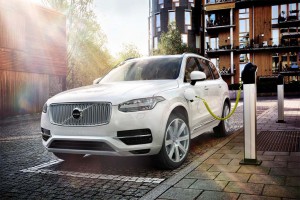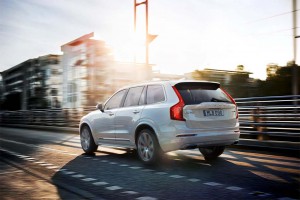
The Volvo XC90 T8 Twin Engine is selling at a higher rate than expected by company executives: 20%..
Despite generally sluggish demand for battery-electric vehicles, Volvo Cars has a surprise hit on its hands with its first plug-in hybrid model, according to the Swedish automaker’s global R&D chief.
About 20% of the buyers of its new XC90 are opting for the so-called Twin Engine version of the sport-utility vehicle, more than double the company’s original expectations. The plug-in powertrain will next be offered in the S90 sedan and V90 wagons that share platforms with the SUV. And the strong response is encouraging Volvo to look at still more electrification options, said research chief Peter Mertens, during an interview.
Among other things, Volvo is readying its first full battery-electric model for 2019, with others soon to follow. And Mertens revealed the carmaker, now owned by China’s Geely, is looking closely at new lithium-ion battery technology that could allow a motorist to get a full charge in about the same time it takes to fill up a gas tank.
Volvo is perhaps best-known for its long-time focus on safety, and that’s an area it will continue to target. The S90, for example, will be the first vehicle on the road to come with semi-autonomous technology, dubbed Pilot Assist, as standard equipment. But Volvo has been putting an increasing emphasis on electrification, as well.
The initial reception for its Twin Engine hybrid system — introduced on the XC90 and set to be added to the S90 and V90 powertrain line-up next year – has far outstripped expectations.
“We were planning for 10% (of total XC90 sales),” said Mertens, “then we said 15%.” It has jumped to 20%, and “frankly we did not expect that.” Though pleased by the reception for the plug-in, Mertens cautioned that, “I don’t know how sustainable that is over time.”
(To see what’s new from Volvo for 2017, Click Here.)
Volvo is planning to add plug-in versions of other models in its line-up, notably including the next-generation 40-Series, which is expected to debut next year. While the R&D chief won’t go into great detail, he did note that the Twin Engine system developed for its compact platform, dubbed CMA, will be “a much more simple solution” than the technically complex powertrain in the 90-Series models.
It will use a three-cylinder version of Volvo’s new V-engine family paired to an electric motor through a dual-clutch transmission. Power will be directed to the front wheels only. The lithium-ion batteries, meanwhile, will be housed in the driveshaft tunnel, as with the plug-in 90-Series vehicles.
The next big step will come in 2019, when Volvo rolls out its first fully electric model. Mertens declined to say whether the first BEV will be based on the small CMA platform or the big SPA architecture, but “from a technical point of view, it doesn’t matter,” he stressed, noting that, “eventually, it will be used on both platforms.”
Within the next decade or less, said Mertens, “We will offer (full) battery-electric power on all of our vehicles.”
(Volvo planning to add plug-in hybrid options across its product range. Click Here for more.)
He stressed that Volvo’s approach will be to make plug-in and BEV options available, much like today’s gas and diesel-powered engine variants. Volvo will not do “an odd-looking vehicle” designed specifically for electrification. Both the SPA and CMA platforms were specifically designed with battery power options in mind.
How much demand there will be long-term is not yet clear, according to the executive. Automakers and their battery suppliers have to solve several challenges, including range and cost. Another issue is the time it takes to charge a battery.
But Mertens said Volvo is in discussion with an unnamed battery company that is developing a version of lithium-ion chemistry that could be recharged in about the same time it would take to fill a conventional gas tank.
“A 10-minute charge would be an absolute breakthrough,” said Mertens. “Anything better would be too good to be true.”
(Volvo unveiled its new XC40 and S40 concepts. Click Here to get a look.)
How soon such new batteries might be in a Volvo car is unclear. A key challenge, he cautioned, will be making sure that fast-charge technology can last out the full 10-year warranty the maker now offers on its batteries.


